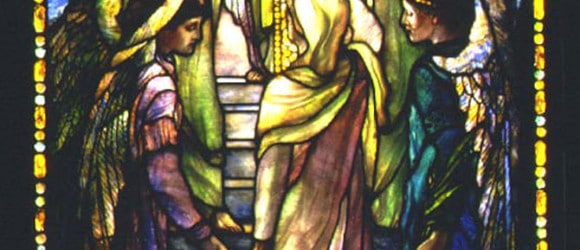Stained Glass for Mausoleums
- At March 22, 2013
- By Doug Keister
- In Doug Keister's Blog
0

When I travel to cemeteries, I often hear from managers, “We have some great Tiffany windows in our private mausoleums as well as in our community mausoleums.” I’m often tempted to tell them that I doubt that, but I usually hold my comments. Why don’t I think they have some great Tiffany windows? Simply put, Tiffany windows are relatively rare in mausoleums. Truth-be-told, I have seen some spectacular Tiffany windows in private mausoleums (many worth upwards of one million dollars), but, again, they are not commonplace.
Tiffany windows are a brand of stained glass window, just like Kleenex is a brand of facial tissue and Scotch Tape is a brand of clear adhesive tape. In fact, Tiffany windows really aren’t even stained glass windows; they are art glass (also known as colored glass) windows. Stained glass is technically glass that is painted (stained). The painted glass is then fired in a kiln to set it. Painted glass is typically used for faces and other details that are too nuanced to effectively portray with pieces of colored glass.
Nowadays, almost any type of colored or painted glass is called stained glass. Colored stained glass is created by adding metallic salts to glass during its manufacture, making the entire glass colored rather than just the surface. Stained glass in the form of vases and other objets d’art, has been around since ancient times, and was used extensively by the Egyptians and Romans.
Stained glass windows were extensively used in cathedrals during the Middle Ages (the fifth to the fifteenth centuries), with most examples dating from after 1100 AD. Because of their durability, they are often the best touchstones of artistic styles during specific periods of time. Unfortunately, by the eighteenth century, true stained glass windows gave way to painted glass windows, and the craft of producing stained glass windows almost died out.
However, in the late nineteenth century, Louis Comfort Tiffany and others (most notably John LaFarge) popularized the use of opalescent glass. It is essentially glass that has more than one color in it. The artful blending of these multi-textured pieces of glass became known as the American Glass Movement.
The use of true stained glass died out again after the death of Tiffany in 1933, but was resurrected in the 1960s and continues to thrive.
When selecting a stained glass window for a mausoleum, pay particular attention to the type of glass used, and the construction techniques. True stained glass (art glass) will last much longer than painted glass. Some artists join pieces of glass with lead “came”, where the glass is positioned in a lead channel. Other artists apply copper foil to the edges of the glass, and then use solder to join the pieces. Stained glass windows tend to be heavy and pliant, so make sure there are reinforcing pieces ensuring that the window doesn’t bend. While a wood frame may work for a home, it won’t stand the test of time required for a mausoleum. Bronze generally works best, but steel, if properly treated, also works.
Like most things in life, you get what you pay for. Text and photo © Douglas Keister Visit Doug’s Author Page.
